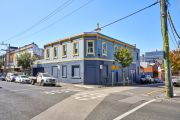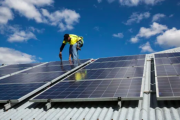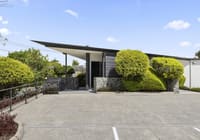
Rise in food delivery leading to smaller fast-food restaurants
Online food delivery services are making it easier for fast food retailers to downsize their real estate, property insiders say, but operators admit the delivery commission costs are cutting into their profits.
Dean Venturato, from Burgess Rawson, said the rise of online food aggregators, such as UberEats and MenuLog, have reduced fast food operators’ requirement for large sites, as a proportion of diners are not ordering or consuming in-store.
“What it does is it enables food operators in which would traditionally look at one large site because of the car parking requirements, the footprint and setback and all the other government planning regulations, it enables them to position themselves on smaller sites,” Mr Venturato said at the launch of the property agency’s Fast Food Property Investment Report in Sydney.
“These days we’re going high-rise and so they can position themselves in a smaller footprint and still achieve the same sale as they would achieve on a larger footprint.”
But for drive-through retailers, up to 60 per cent of the turnover come from drive-through impulse ordering, rather than walk-ins, said Neil Honan, of Honan Partners Chartered Accountants, who does due diligence on fast food properties for clients.
“So they need that big site, typically 1600 to 2000 square metres of land as a minimum to have a drive-through,” he said.
“And of course, if you have that Macca’s sign there, that’s advertising everyday for 25,000 or 30,000 cars that go past it. It’s brand advertising and (in comparison), it costs them $100,000 to put up a sign.”
Fast food property yields have compressed from a median 7 per cent in 2012 to 4.92 per cent in the 2017/18 financial year across metropolitan and regional locations, Burgess Rawson’s report found.
A Guzman y Gomez fast food store in NSW’s Coffs Harbour sold on a 4.5 per cent return in December 2017 to a buyer from Perth, despite its regional location. This is on par with metropolitan yields, the report says.
“As the commercial investment market continues to grow, investors are often placing more importance on the asset class as opposed to geographical location,” Burgess Rawson’s Simon Staddon said.
“The yield differential for fast food assets in metropolitan and regional areas has narrowed. There is now a minimal yield difference between the two.”
The median sale value of a fast food property more than doubled from $1,928,000 in 2012 to $3.18 million in the 2017/18 financial year.
Buyers can nab a fast food asset from less than $1 million up to $9 million, with incomes starting about $35,000 a year for a regional investment.
“Food delivery isn’t going away”
Simon Johnson, Mexican food chain Guzman y Gomez’s chief development officer, told Commercial Real Estate that while online food delivery services have helped them access diners at home and in offices, the commission costs are high.
“Our guests are also eating Guzman y Gomez more often so we look at food delivery as a marketing channel as much as a delivery channel. Yes, food delivery has certainly contributed to increased sales but with the commissions involved in getting Guzman y Gomez into homes and offices, there’s obviously a cost associated which isn’t ideal,” he said.
“The delivery channel is one where we take a hit on margins but we’re always working on our efficiency and our partners to reduce costs.”
Mr Johnson stressed that the company’s approach is “that food delivery isn’t going away”.
“We’re fully invested in making it worth but we work on solutions and we use technology to re-invent fast food including leading the way with drone delivery.”
The chain was trialling food deliveries with drones – which can travel at up to 120 kilometres an hour – in the Australian Capital Territory and Queanbeyan regions late last year with X, part of California-based Alphabet, which owns Google.
When asked whether Guzman y Gomez would consider smaller sites to accommodate the rise of food delivery and save on property costs, Mr Johnson said that they “constantly look at these options”.
“At Guzman y Gomez, we want all our guests to experience our unique and vibrant culture of our staff, so ideally we would do smaller stores with delivery rather than invest in dark kitchens.”
“Dark kitchens” are where the space is not open for the public to dine in the restaurant but operates only for online orders.
Food delivery platform Deliveroo is building 15 dark kitchens across Australia, named Deliveroo Editions. They provide the spaces for free to restaurants but charge a higher commission fee – up to 35 per cent – to businesses when customers order through Deliveroo.
Mr Johnson said that the new Guzman y Gomez restaurant in Sydney’s Lane Cove would be smaller to cater for online food deliveries.












